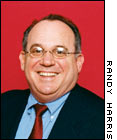NEW YORK (Money Magazine) - Even bulls look up once in a while to see where they're charging. That's what Ed Kerschner, UBS Warburg's chief global strategist, seems to be doing these days.
After years of pounding the table for stocks, Kerschner put the brakes on in 2002 and now favors stocks simply because, next to cash and bonds, they're the least of three evils.
| Wall Street's take on 2003
|

|
|
|
|
At first glance, the strategist still seems bullish. After all, he believes the market hit a bottom in October when the S&P 500 reached 785 and that it should gain 15 percent this year to 1025.
But despite a lofty S&P target and a model portfolio weighting of 88 percent in equities (up from 2002's 78 percent), he just can't muster up much enthusiasm. "It's not that stocks are so attractive," he says. "It's that money-market funds are returning just 1 percent and bonds are yielding just 5 percent."
 |
|
| Ed Kerschner, chief global strategist UBS Warburg |
Kerschner has a lot of issues with equities right now. He's hell-bent on avoiding telecom, where he sees far too much overcapacity.
He's also wary of companies that rely heavily on overseas sales. The U.S. runs the risk of acting like an empire, he says, and it could become increasingly isolated and disliked. Besides weakening the dollar, that could hurt U.S. brands. Antiglobalization protesters, he notes, have attacked McDonald's and Starbucks. And Coca-Cola is facing a consumer boycott in the Middle East and North Africa. "It could be risky if around the world it's ugly to smoke a Marlboro cigarette or eat a Big Mac," he says.
Nevertheless -- some picks
So what sectors are going to power that 15 percent rise in the S&P? "We have the narrowest sector underweights and overweights that I ever remember doing," says Kerschner.
| 1-year return through Jan. 17. P/E based on estimate for next fiscal year. Growth from current estimate to next year's estimate. | | Source: Baseline |
|
But while he doesn't see any breakout winners, he expects decent growth from the basic-materials sector. Unlike companies in most sectors, basic-materials companies didn't overexpand during the boom. And so companies like Dow Chemical and Finnish paper company upM-Kymmene, which have P/Es close to five-year lows, will benefit from pricing power, says Kerschner.
Investors can also find opportunities in companies that are able to squeeze more revenue out of existing assets, he says. In the 1990s, many companies grew by merger or acquisition because they had access to such cheap capital.
Those days are over, says Kerschner, and investors should look to companies that can wring better performance out of what they've got.
Example: Colgate-Palmolive. Since the 1920s, Colgate has had to maintain manufacturing and distribution plants around the world, largely because transportation was very expensive. Today, however, transportation is cheap. So instead of making acquisitions in order to grow, Colgate has been able to reduce the number of plants it operates overseas and maintain sales growth of 5 percent to 7 percent.
Other companies that have a similar dynamic in place include industrial-supplies distributor Grainger and leading hospital operator HCA, which trade for 20.6 and 15.5 times estimated 2003 earnings, respectively.

|

